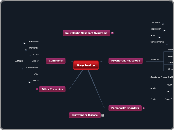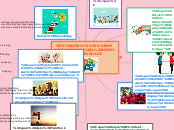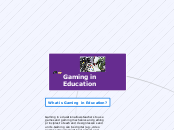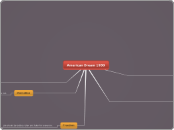Neuroleptic Malignant Syndrome
NMS is a life threatening condition related to an adverse reaction to anipsychotic drugs. Mnemonic for remembering the symptoms:
F - Fever > 38 C
A - Autonomic instability(v. labile blood pressure)
L - Leucocytosis
T - Tremor
E - Elevated Enzymes
R - Rigidity of the muscles.
Binswanger Disease
Psychiatry
Other Therapies
Exercise
Diet
PSPD
Group therapy
Family Therapy
ECT
DBT
CBT
There are three subtypes of ADHD:
1) Hyperactive-impulsive subtype. Some features of this type of ADHD are that a child may fidget a lot, run around in inappropriate situations, have difficulty playing quietly and may talk excessively. They may interrupt others and have trouble waiting their turn in games, in conversations and also in queues.
2) Inattention subtype. In this subtype, a child may have trouble concentrating and paying attention, may make careless mistakes, may not listen or follow through on instructions and may be easily distracted. They may also be forgetful in daily activities, lose essential items such as school books or toys, and have trouble organising activities.
3) Combined subtype. If a child has this subtype, they have features of both of the other subtypes.
OCD
DSM IV/ ICD 10
icd 10 schizophreni
1. Characteristic symptoms: Two or more of the following, each present for much of the time during a one-month period (or less, if symptoms remitted with treatment).
Delusions
Hallucinations
Disorganized speech, which is a manifestation of formal thought disorder
Grossly disorganized behavior (e.g. dressing inappropriately, crying frequently) or catatonic behavior
Negative symptoms: Blunted affect (lack or decline in emotional response), alogia (lack or decline in speech), or avolition (lack or decline in motivation)
If the delusions are judged to be bizarre, or hallucinations consist of hearing one voice participating in a running commentary of the patient's actions or of hearing two or more voices conversing with each other, only that symptom is required above. The speech disorganization criterion is only met if it is severe enough to substantially impair communication.
2. Social or occupational dysfunction: For a significant portion of the time since the onset of the disturbance, one or more major areas of functioning such as work, interpersonal relations, or self-care, are markedly below the level achieved prior to the onset.
3. Significant duration: Continuous signs of the disturbance persist for at least six months. This six-month period must include at least one month of symptoms (or less, if symptoms remitted with treatment).
A minimum of one very clear symptom belonging to any one of the groups
listed below as (a) to (d) or symptoms from at least two of the groups
referred to as (e) to (i) should have been clearly present for most of the
time during a period of 1 month or more.
a) Thought echo, thought insertion or withdrawal and thought broadcasting
b) delusions of control, influence or passivity, clearly referred to body or limb movements
or specific thoughts, actions or sensations; delusional perception
c) hallucinatory voices giving a running commentary on the patient’s behaviour or
discussing the patient among themselves, or other types of hallucinatory voices coming
from some part of the body
d) persistent delusions of other kinds that are culturally inappropriate and completely
impossible, such as religious or political identity, or superhuman powers and abilities
(e.g. being able to control the weather or being in communication with aliens from
another world)
e) persistent hallucinations in any modality, when accompanied either by fleeting or
halfformed delusions without clear affective content or by persistent over-valued ideas,
or when occurring every day for weeks or months on end.
f) breaks or interpolations in the train of thought, resulting in incoherence or
irrelevant speech, or neologisms
g) catatonic behaviour, such as excitement, posturing. or waxy flexibility, negativism,
mutism and stupor
h) ‘negative’ symptoms such as marked apathy,
paucity of speech and blunting or incongruity of emotional responses, usually resulting
in social withdrawal and lowering of social
performance; it must be clear that these are
not due to depression or neuroleptic
medication
i) a significant and consistent change in the
overall quality of some aspects of personal
behaviour, manifest as loss of interest,
aimlessness, idleness, a self-absorbed
attitude and social withdrawal.
First Rank Symptoms
Audible thoughts (thought echo)
Voices heard arguing
Voices heard commenting on one's actions
Somatic/thought passivity experiences (delusions of control)
Thought withdrawal
Thought insertion
Thought broadcasting
Delusional perception
Bipolar
Subtopic
Treatment is dependant on the overriding symptoms.
ICD 10
1. The patient must have been exposed to a stressful event or situation (either short or long lasting) of exceptionally threatening or catastrophic nature which would likely cause pervasive distress in almost anyone.
2. There must be persistent remembering or reliving of the stressor in intrusive flashbacks, vivid memories or recurring dreams, or in experiencing distress when exposed to circumstances resembling or associated with the stressor.
3. The patient must exhibit an actual or preferred avoidance of circumstances resembling or associated with the stressor.
4. Either of the following must be present-:
Inability to recall either partially or completely some important aspect of the period of exposure to the stressor, OR
Persistent symptoms of increased psychological sensitivity and arousal shown by any two of the following:
Difficulty falling or staying asleep
Irritability or outbursts of anger
Difficulty concentrating
Hypervigilance
Exaggerated startle response
DSM IV
A: Exposure to a traumatic event
This must have involved both (a) loss of "physical integrity", or risk of serious injury or death, to self or others, and (b) a response to the event that involved intense fear, horror, or helplessness (or in children, the response must involve disorganized or agitated behavior). (The DSM-IV-TR criterion differs substantially from the previous DSM-III-R stressor criterion, which specified the traumatic event should be of a type that would cause "significant symptoms of distress in almost anyone," and that the event was "outside the range of usual human experience.
B: Persistent re-experiencing
One or more of these must be present in the victim: flashback memories, recurring distressing dreams, subjective re-experiencing of the traumatic event(s), or intense negative psychological or physiological response to any objective or subjective reminder of the traumatic event(s).
C: Persistent avoidance and emotional numbing
This involves a sufficient level of:
avoidance of stimuli associated with the trauma, such as certain thoughts or feelings, or talking about the event(s);
avoidance of behaviors, places, or people that might lead to distressing memories;
inability to recall major parts of the trauma(s), or decreased involvement in significant life activities;
decreased capacity (down to complete inability) to feel certain feelings;
an expectation that one's future will be somehow constrained in ways not normal to other people.
D: Persistent symptoms of increased arousal not present before
These are all physiological response issues, such as difficulty falling or staying asleep, or problems with anger, concentration, or hypervigilance.
E: Duration of symptoms for more than 1 month
If all other criteria are present, but 30 days have not elapsed, the individual is diagnosed with Acute stress disorder.
F: Significant impairment
The symptoms reported must lead to "clinically significant distress or impairment" of major domains of life activity, such as social relations, occupational activities, or other "important areas of functioning".[67]
Lewy Body
Memantadine
Levodopa
Cholinesterase inhibitors.
Due to hypersensitivity to neuroleptics, prevention of DLB patients taking this drugs is of great importance Quetiapine and Clozapine have been used effectively to control hallucinations, typical antipsychotics can exacerbate symptoms or cause hypersensitivity reaction.
People with DLB are at risk for Neuroleptic Malignant Syndrome.
Other medications, including drugs for urinary incontinence and the antihistamine medication Benadryl can also exacerbate dementia.
Core Features are:
1) fluctuating cognition with great variations in attention and alertness from day to day and hour to hour
2) recurrent visual hallucinations (observed in 75% of people with DLB). Usually animals or people who aren't there.
3) motor features of Parkinson's
Also suffer from mis-inetrpretation, i.e, sock for snakes, bin for urinal.
Lewy body is an overlap disease between Alzheimer's disease and Parkinson's Disease.
Vascular
Manage RFs
Like AD but their defecits are more patchy.
Lateralising signs.
Full work-up:
FBC
U&E
B12
TFT
LFT
ESR
Ca
CRp
Folate
Lipid Profile
Glucose
Syphilis screen
ECG
CT Head
Second most common form of dementia worldwide
More common in Asia
M>F
More sudden onset than Lewy body/AD dementia.
More focal neurological signs, can be very focal and imitate other dementias. e.g. frontal lobe vascular dementia can imitate Pick's disease.
RF:
Lifestyle
Alzheimers
Psycho-social
Behavioural
Emotional
Cognitive
Stimulation
Acetylcholoinesterase inhibitors:
Rivastigmine (Exelon Patch)
Galantamine
Donepizil
NMDA Receptor antagonist:
Memantadine
Definition & Diagnosis
General cerebral atrophy. Prescenec of amyloid plaques and neruofibillary bundles on PM.
Symptomsd include loss of higher functions:
Apraxia
Agnosia
Aphasia
Apathy
Most common form of dementia.
Progressive. Uncurable.
Risk factors include:
Lifestyle
Age
Sex (F>M)
Picks Disease
Frontotemporal lobe degeneration
Tau proteins build up in neurone:
Pick Bodies
Aphasia & Personality Change are cardinal
symptoms and differentiate from PD.
Management
Non-pharma inetrventions
Symptoms & Diagnosis
Diagnostic criteria:
Persistent sadness or low mood
Marked loss of interests or pleasure
At least one of these, most days, most of the time for at least 2 weeks.
If any of above present, ask about associated symptoms:
Disturbed sleep (decreased or increased compared to usual)
Decreased or increased appetite and/or weight
Fatigue or loss of energy
Agitation or slowing of movements
Poor concentration or indecisiveness
Feelings of worthlessness or excessive or inappropriate guilt
Suicidal thoughts or acts
Severe
Moderate
Moderate depression: symptoms or functional impairment are between 'mild' and 'severe'
Mild
DSM-IV severities of depression
Subthreshold depressive symptoms: fewer than 5 symptoms
Mild depression: few, if any, symptoms in excess of the 5 required to make the diagnosis, and symptoms result in only minor functional impairment
Epidemiology
Personality Disorders
ICD 10/ DSM IV
DSM-IV
An enduring pattern of psychological experience and behavior that differs prominently from cultural expectations, as shown in two or more of: cognition (i.e. perceiving and interpreting the self, other people or events); affect (ie. the range, intensity, lability, and appropriateness of emotional response); interpersonal functioning; or impulse control.
The pattern must appear inflexible and pervasive across a wide range of situations, and lead to clinically significant distress or impairment in important areas of functioning.
The pattern must be stable and long-lasting, have started as early as at least adolescence or early adulthood.
The pattern must not be better accounted for as a manifestation of another mental disorder, or to the direct physiological effects of a substance (e.g. drug or medication) or a general medical condition (e.g. head trauma).
ICD-10
Markedly disharmonious attitudes and behaviour, involving usually several areas of functioning, e.g. affectivity, arousal, impulse control, ways of perceiving and thinking, and style of relating to others;
The abnormal behaviour pattern is enduring, of long standing, and not limited to episodes of mental illness;
The abnormal behaviour pattern is pervasive and clearly maladaptive to a broad range of personal and social situations;
The above manifestations always appear during childhood or adolescence and continue into adulthood;
The disorder leads to considerable personal distress but this may only become apparent late in its course;
The disorder is usually, but not invariably, associated with significant problems in occupational and social performance.
ICD10 adds that 'For different cultures it may be necessary to develop specific sets of criteria with regard to social norms, rules and obligations.'
Treatment
Types
Cluster C: Anxious, fearful
Avoidant
Obsessive-Compulsive
Dependant
Cluster B: Emotional, erratic
Histrionic
Borderline
Narcissistic
Anti-Social
Cluster A: Eccentric
Schizoid
Paranoid
Schizotypal
Psycho-pharmacology
Mania
Mood Stabilizers
Anxiety
GAD
PTSD
Substance Misuse & Withdrawal
Nicotine
Varenicline
*High risk of depression
Bupropion Hydrochloride (Zyban)
Opioid
Naltrexone: Relapse Prevention
Methadone
Buprenorphine (Subutex)
Alcohol
Long acting Benzodiazepines
Disulfiram (Antabuse)
Acamprosate
Pabronex
Insomnia
Melatonin
Antihistamines
Anxiolytics
Hypnotics
Zopiclone
Schizophrenia
Depot Injections
Pipotiazine Palmitate
Fluphenazine
Typical Antipsychotics
Side Effect profile
Extra Pyramidal Side effects:
Parkinsonism
Dystonia
Akathisia
Tardive Dyskineasia
Neurioleptic Malignant Syndrome
Hypotension and interfereence in temperature regulation
Zuclopenthixol
Prochlorperazine
Pericyazine
Flupenthixol
Haloperidol
Atypical Antipsychotics
Side effect profile:
Weight Gain
Dizziness
Postural Hypotension
Reflex Tachycardia
ESPs (usually mild)
Hyperglycaemia
Risperidone
Quetiapine
Olanzapine
Agranulocytosis!!!!
Clozapine
Aripiprazole
Amisulperide
ADHD
NICE guidelines
Drugs from part of comrehensive treatment programme.
Modafinil (Provigil)
Dexamphetimine Sulphate (Dexedrine)
Methylphenidate Hydrochloride (Ritalin/Concerta)
Atomoxetine (Strattera)
Depression
Others
Tryptophan
Reboxetine
Venlafaxine
Mirtazpaine
Flupentixol
Duloxetine
MAOIs
Monoamineoxidase inhibitor:
MAO-A & MAO-Bdeaminase serotonin, epinephrine, nor-epinephrine and melatonin. Inhibiting the enzymes increases the extracellular concentration of these neurotransmitters.
AVOID TYRAMINE CONTAINING FOODS MAY LEAD TO UNCONTROLLED HYPERTENSION.
Postural hypotension
Diziness
GI disturbance
Reversible MAOI:
Moclobemide
Tranylcypromine
Isocarboxazid
Phenelzine
SSRIs
Selective Serotonin Reuptake Inhibitors.
Prevents reuptake of serotonin from the synaptic cleft into the pre-synaptic cell.
Fewer anti-muscarinic & cardiooxic s/e than TCAs
GI: Nausea, vomiting, diarrhoea, constipation, dyspepsia
Anoerxia
Weight loss & weight gain
Hypersensitivity rash
Sexual dysfunction
Sertraline
Paroxetine
Fluoxetine
Escitalopram
Citalopram
Tricyclics
Mechanism
Mostly serotonin-norepinephrine reuptake inhibitors.
Therefore increase levels of theses neurotransmitters in the brain. They have no effect on dopamine transporters. They are potent Sodium channel blockers, which is why they are cardio toxic.
Side Effect Profile
Drowsiness
Dry mouth
Blurred vision
Constipation
Urinary retention
Hepatic & Haematological reactions
Convulsions
Heart Block
Arrhythmias
Drugs
Trazodone
Nortriptyline
Doxepin
Dosulepin
Clomipramine
Amitriptyline
Dementia
Acetylcholinesterase Inhibitors
Side effects
Cautions:
Sick Sinus Syndrome
Supraventricular conduction disorders
Cholinergic Effects
Nausea
Vomiting
Insomnia
Dyspepsia
Syncope
Agents
Rivastigmine
Galantamine
Donepezil
Conditions
Alzheimer's
LBD
NMDA Receptor blocker
Side effects:
Constipation
Hypertension
Headache
Drowsiness
Memantine
Vascular Dementia
Beta blockers
ACE Inhibitors
Statin
DM II control









